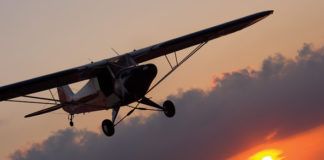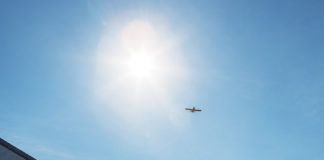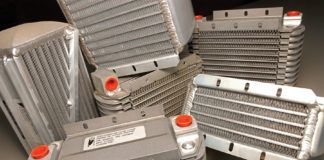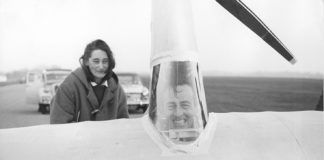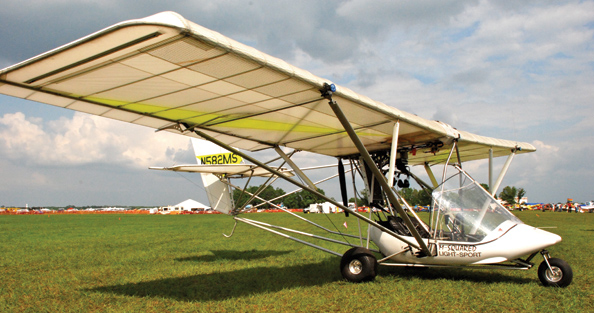
What makes an airplane fly? If the plane is an M-Squared, it’s not the wing and it’s not the engine. It’s not money, either, though that certainly helps. No, what makes an M-Squared fly is the rudder. Repeat: It’s a rudder airplane.
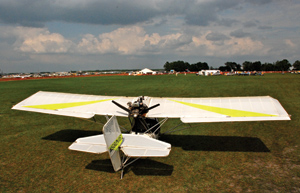
Slow speeds mean huge wings. The Breese has 173 square feet of wing area, almost as much as high-wing Cessnas.
Old-timers may observe that the M-Squared resembles the Quicksilver, and part of that is because the ebullient Paul Mather, head honcho at M-Squared, was VP of sales and marketing at Quicksilver through 19 years and six bankruptcies. He left in late 1995, started M-Squared in ’96, and had his first plane flying 18 months later, after designing and testing the plane extensively before its first flight. In the first year, M-Squared sold 100 kits, but then came the collapse of the ultralight market. Total sales to date are around 400.
With all of his experience in the business, Mather has some great perspectives, coming from both customer and liability considerations. If you buy one of his airplanes, he’d prefer to sell it to you ready to fly. Come to the factory, get a 5-hour checkout, and fly it home. Did you buy a used one? Come to the factory and get 5 hours of training. Want to build it yourself, ELSA or Experimental/Amateur-Built? Come to the factory and do it there, but he’d still prefer to sell it ready to fly at the same price as the kit. If you insist on going the traditional kitbuilt route, it is open to you—mostly. M-Squared has A&Ps, CFIs, everybody you might want at the home airport—not necessarily M-Squared employees, but available. But Mather says that by the time they package the parts of a kit, the savings to the customer is minor, so they won’t send you one. Please, if you must build, build at the factory.

Company President Paul Mather in a typical pose, enjoying life, his family and his airplanes.
Mather’s approach stems from watching builders struggle with even simple matters, and that informs his view of the homebuilt landscape. He doesn’t always believe the experts, either. Some told him that he needed to sell a genuine, conforming Part 103 ultralight, but he had his doubts. He has such a design for sale, but in the last three years he’s sold only one.
Wing’s the Thing
The rest of the M-Squared product line now includes seven Experimentals and LSAs—both as ready-to-fly SLSAs and as ELSAs. In terms of the Breese DS, all three versions (E/AB, ELSA and SLSA) are the same basic airframe, and all cost the same: $34,995. The two LSAs differ only in the wing; the one we flew had a double-surface wing with covering top and bottom, and it cruises and climbs faster. The other wing has a single covering on the top of the wing only. That wing is 30 pounds lighter, but with more camber the single-surface wing has a lower stall speed (28 mph versus 34), and it is the preferred wing for flying with floats.
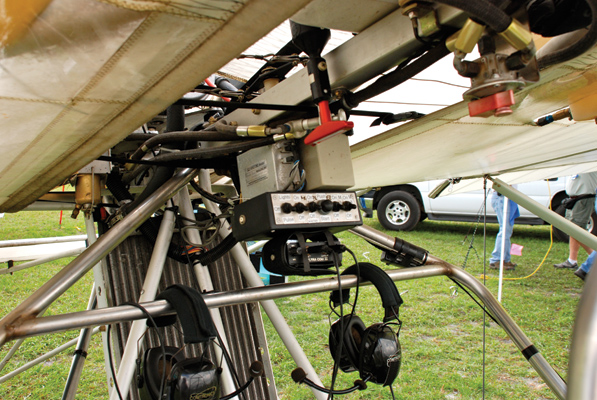
There are switches in the overhead, just like on the big jets—electricals, intercom, primer and fuel selector.
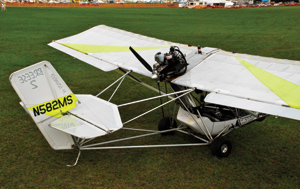
Most of the struts are structural, but one is the elevator pushrod control.
For the technically inclined, note that the airfoil on the Breese is a 560×15. Never heard of it? This airfoil has a flat bottom, enforced by a straight tube, whereas the top surface is another aluminum tube with the leading edge bent over a Volkwagen wheel, one that fits—you guessed it—a 560×15 tire. The actual tires on this plane looked like golf cart tires because, well, they are: size 800×6. The stock tires are recommended for asphalt.
The engine is a Rotax 582 blue head, the only engine Mather will have on his airplanes. Indeed, he says that one of the three fatalities in his aircraft occurred when a builder installed a different engine whose gearbox came off—the second time it had come loose—and sliced through one of the booms holding the tail assembly on. (One of the other accidents came from an intoxicated pilot, and the last came from a pilot who had an engine failure after takeoff in excessively high winds and was unsuccessful in trying to make it back to the airport.)
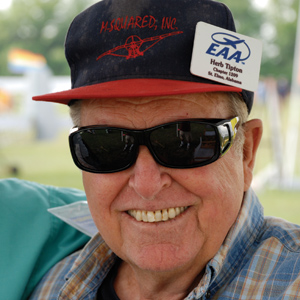
CFI Herb Tipton, still enjoying flying at age 75, and setting a mark for the rest of us.
Committing Aviation in Florida
We flew the Breese 2 with the double-surface wing at Sun ’n Fun on a morning with just enough thermals and wind, say, 5 gusting to 12, to get a good feel for the airplane. The preflight mantra is, “It’s a rudder airplane.” Mather mentioned this several times, as did CFI Herb Tipton, a spry 75-year-old. I dutifully repeated, “It’s a rudder airplane.” Got it. Right.
(For the historically minded, the original Quicksilver had a control stick, no pedals, and the stick worked the elevator and rudder—no ailerons. Then Quicksilver added foot pedals that controlled ailerons, and the final version had conventional stick and rudder.)
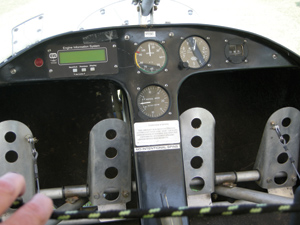
The Breese features a compact instrument panel and big rudder pedals. It is a rudder airplane, you know.
Safety is more than a slogan with M-Squared, as Tipton did a thorough preflight, followed with a second one by mechanic Paul Hockin, and then Mather triple checking a few points. Impressive. As part of the preflight, I was cautioned against touching the propeller. Because it is downstream of the oil-rich two-stroke engine exhaust, it is coated with condensed petroleum products that are apparently hard to remove with anything that you would want in contact with your skin. I took his word for it.
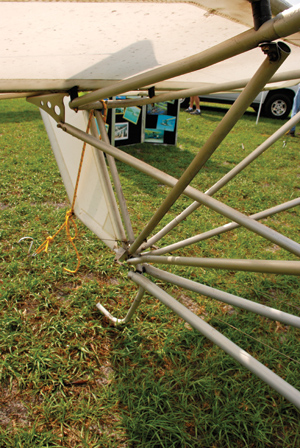
All of those struts have to go somewhere! In addition to the strut used for the elevator pushrod control, six go to the fuselage tub, and two go to the stabilizer leading edge.
After the flagman cleared us for takeoff, we bumped down the runway with 450 pounds of thrust propelling 1000 pounds of aircraft. Liftoff was at 35 mph, and we stayed low to build up speed to about 50 mph before starting the climb. As I tried out the pitch controls and got used to the sight picture, we climbed at 60 to 70 mph. The elevator is light and powerful, and perhaps its biggest limitation is that the center stick has the grip high enough that you can end up flying with your arm muscles instead of your fingertips.
It’s a Rudder Airplane
Climbing out, I flew with the rudder, remembering the advice offered during the walk-around. More specifically, the Breese is a rudder only airplane. Don’t use the ailerons. Control was easy, but the gentle chop and the general unfamiliarity made me wonder if I was really doing things right.
Back to the rudder. The ailerons are used mostly for generating adverse aileron yaw (Tipton demonstrated their proclivity for doing that) and for keeping overbanking tendency under control in turns of 30° or 45° or even 10°. Tipton demonstrated each of the steeper turns for me, emphasizing the rudder for entry and recovery. My turns went well, considering the choppy air, but learning to use more rudder, more quickly, is part of the learning curve. At the relatively low airspeeds, 70 mph or so, a 45° banked turn gets you turned around right smartly.
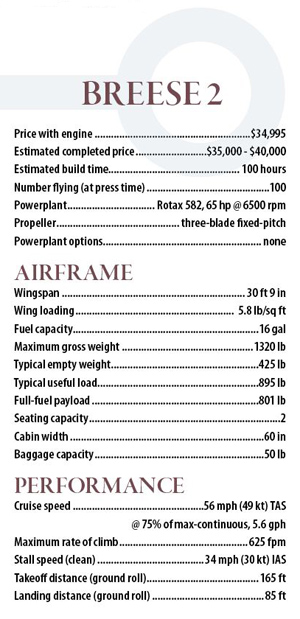
The roll rate entering and exiting the turns is mellow, because you’re using only the rudder. It was easy to make 45˚ banked turns, and the unstable atmosphere presented enough minor challenges to get a better feel for the controllability of the airplane. Sometimes it felt just like thermalling a sailplane because of the visual illusion that the inside wing was moving backwards.
Next, Tipton demonstrated stalls. The technique is to build up enough speed to pull the nose up to the horizon, like in a glider, and keep the wings level with the rudder. After a short while, the nose fell through with maybe a smidgen of a stall buffet, and there was a minor tendency to fall off on either side that was easily controlled with the rudder. Seemed simple enough. I tried some, but on the first two didn’t build up enough speed and wasn’t able to pull the nose up to get a nice break. Instead, the nose would start to fall through early. Tipton reports that with full power and the high thrust line, there is not enough elevator authority to overcome the power-induced nose-down tendency. In any event, stalls are benign.
Flying straight and level, the noise level with the headsets was tolerable, and the view out front was great with that really low instrument panel. Sitting under the wing provided cooling shade, the clouds kept us from receiving direct sunlight, and there was a gentle breeze through the cockpit. The cockpit has no back wall, so part of the drill is to make sure that there’s nothing to come off and go through the prop. I left my baseball cap on the ground.
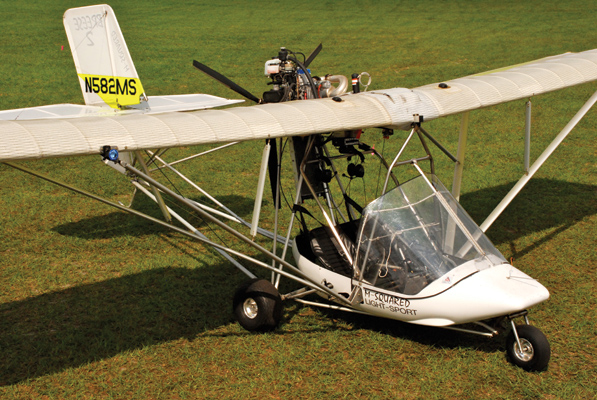
The Breese’s design is more utilitarian than sexy sleek, but in flight the spectacular view looking out makes the view looking in utterly irrelevant. Tires on this Breese are golf cart type, which work well on landing, but the stock tires are better on asphalt. The high wing provides good shade from that big windshield.
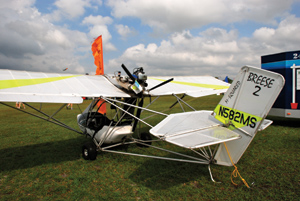
On the Breese, you’ll find a huge rudder, no vertical fin. But because you fly mostly with the rudder anyway, the lack of fin area is hardly noticeable.
Real Flying
While doing all of this evaluation and familiarization, it was easy to overlook the great view and the fun flight experience of the Breese. The slow speeds meant that we hit wallows in the air, not bumps. Like other low-and-slow aircraft, sightseeing and flying itself are pleasures unto themselves that don’t require a glass cockpit or aerobatic capability or anything else fancy and expensive. This isn’t a plane to keep up with Joneses; it’s a plane to enjoy flying.
Coming back to Sun ’n Fun, flying straight ahead in the gentle light chop, there was one more lesson. It’s not a rudder airplane in turns or in maneuvers, or where the rudder helps the ailerons or leads them. It’s a rudder airplane all the time. Tipton demonstrated his preferred cross-country technique of trimming the elevator and then leaning back and flying with just his feet. You can do this in a Cessna or most anything else, but those planes have an uncoordinated feel. In the Breese, it felt natural. The elevator trim, however, at your elbow and between the seats, is clumsy to use.
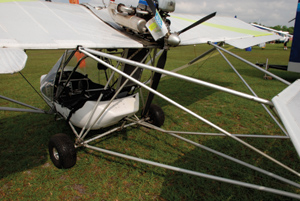
The pusher prop can eat things that happen to blow through it, so be careful! But there’s no prop blast through the cabin.
The ultralight traffic pattern at Sun ’n Fun was empty, and we flew a gradual descent at cruise speed, slowing to 60 mph on short final. With the bumps and the crosswinds on short final and in the flare, Tipton used control inputs to keep the flight path vector aligned. He had mentioned before the flight that the passenger needs to make room for the pilot’s arm movement when operating the controls, and that became clear on the landing.
The last demonstration came from Paul Hockin, and though it did involve the yaw axis, it did not involve the rudder. Rather, it was a demonstration of how to board the airplane quickly and gracefully, though you’d want to practice this technique before demonstrating it in public. Grab the vertical tube just aft of the cockpit with both hands, about shoulder high. (The vertical tube is parallel to the yaw axis). Pretend that you are a pole dancer. Jump into the cockpit, swinging yourself around, and end up seated, facing forward, still hanging on to the pole. Trust me, I’ve seen it done. (There’s a technical term for an airplane that’s easy to board gracefully, the first time, without any practice. It’s called an airliner.)
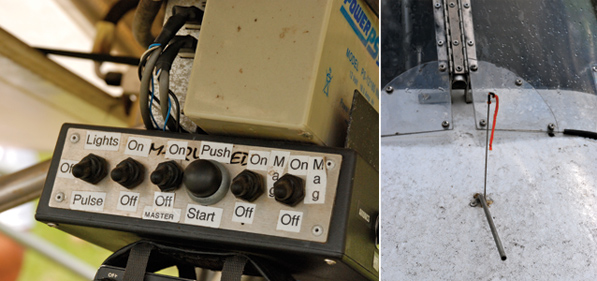
Left: The overhead switch panel. Not easy to read when seated, but not needed much. Right: The yaw string tells you whether you’re flying straight through the air, the same as a skid ball.
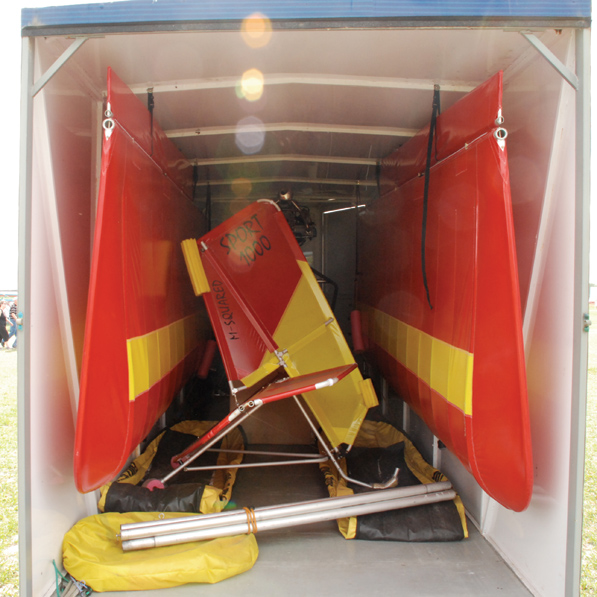
The ultimate toy-hauler toy. Wouldn’t you like to have this trailer? Drive, park for the night, and reconnoiter the area at dusk or at dawn the following day before an exhilarating flight.
Bottom line? Mather’s approach exudes safety in multiple dimensions. As for the Breese, it’s a rudder airplane, and you will almost certainly want a good checkout to fly it comfortably and well. There’s nothing difficult about it, but it is different. If you’re a student of the art of flying, you will enjoy broadening your experience by learning the appropriate techniques. If you have some glider time, especially in 2-33s, some of those sight pictures will come back to you, but probably little experience in other aircraft will transfer.
If you’re looking for an inexpensive way to get in the air, to fly something different, and to enjoy the view, the Breese is worth a look.
For more information, call 251/957-1533, or visit www.msquaredaircraft.com.

![]()
Ed Wischmeyer is an AirCam owner and experienced flight-test pilot who broke free from the tyranny of an Iowa winter to enjoy a lovely spring in Lakeland, Florida, where he flew the Breese, among other back-to-basics designs.

